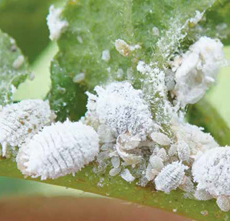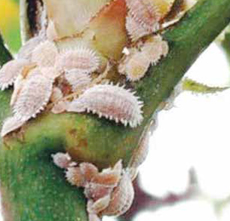 Cut flower cultivation is an art that demands meticulous care and attention to detail. Whether you are a professional floriculturist or an avid hobbyist, the joy of cultivating vibrant, blooming flowers is unparalleled. However, like any other form of agriculture, cut flower growing comes with its own set of challenges, and one persistent problem that often plagues flower growers is the infestation of mealybugs.
Cut flower cultivation is an art that demands meticulous care and attention to detail. Whether you are a professional floriculturist or an avid hobbyist, the joy of cultivating vibrant, blooming flowers is unparalleled. However, like any other form of agriculture, cut flower growing comes with its own set of challenges, and one persistent problem that often plagues flower growers is the infestation of mealybugs.
Mealybugs, members of the Pseudococcidae family, are small, softbodied insects that feed on the sap of plants. These pests can wreak havoc on cut flower crops, causing stunted growth, distorted blooms, and even transmitting plant diseases.
Understanding Mealybugs
Mealybugs are a common menace in horticulture, affecting a wide range of plants, including popular cut flower varieties. These tiny insects have a soft, cottony appearance, often resembling small tufts of cotton or white powder. Mealybugs feed on plant sap by inserting their needlelike mouthparts into plant tissues, extracting nutrients and causing damage in the process.
One of the challenges posed by mealybugs is their rapid reproduction. Female mealybugs can lay hundreds of eggs, leading to exponential population growth if left unchecked. Additionally, mealybugs excrete a sticky substance known as honeydew, which promotes the growth of sooty mold, further compromising the health of the host plant.
Identification of Mealybug Infestation
Early detection is crucial in managing mealybug infestations effectively. The signs of mealybug presence may vary depending on the species and the host plant, but some common indicators include:
Cottony Residue: The most apparent sign of mealybugs is the presence of a cottony, waxy substance on the plant. This residue can be found along stems, leaves, and in the leaf axils.
Stunted Growth: Mealybugs sap the nutrients from plants, leading to stunted growth and development. If your cut flowers are not reaching their expected size or are exhibiting abnormal growth patterns, mealybugs could be the culprits.
Distorted Blooms: Mealybug feeding can cause distortion in flower buds and blooms. Deformed petals and irregularities in flower structure are common signs of infestation.
Honeydew and Sooty Mold: The excretion of honeydew by mealybugs creates a sticky film on plant surfaces. This substance attracts sooty mold, resulting in black, powdery growth on leaves and flowers.
Effective Management Strategies: Controlling mealybugs in cut flower cultivation requires a multifaceted approach that combines cultural, mechanical, and chemical methods. Here are some effective strategies for managing mealybug infestations:
Cultural Practices
Sanitation: Maintain a clean and well-ventilated growing environment. Remove plant debris, fallen leaves, and weeds regularly to eliminate potential hiding spots for mealybugs.
Pruning: Regularly inspect and prune affected plant parts. Pruning can help remove mealybugs and their eggs, reducing the population and preventing the spread of infestation.
Biological Control
Predatory Insects: Introduce natural enemies of mealybugs, such as ladybugs, lacewings, and parasitic wasps. These beneficial insects feed on mealybugs and help keep their populations in check.
 Mechanical Control
Mechanical Control
High-Pressure Water Spray: Use a strong stream of water to dislodge mealybugs from plant surfaces. This mechanical method is effective in reducing mealybug numbers, especially in the early stages of infestation.
Neem Oil and Insecticidal Soap
Neem Oil: Neem oil is a botanical insecticide that disrupts the feeding and reproductive processes of mealybugs. Regular applications can help control infestations while minimizing harm to beneficial insects.
Insecticidal Soap: Insecticidal soaps work by disrupting the cell membranes of mealybugs, causing them to dehydrate and die. These soaps are generally safe for plants and beneficial insects.
Systemic Insecticides
Systemic Products: Systemic insecticides are absorbed by the plant and circulate within its tissues. This makes them effective against mealybugs that are challenging to reach with contact insecticides. However, caution should be exercised to avoid harm to non-target organisms.
Ant Management
Ant Baits: Mealybugs are often tended by ants, which protect them from natural predators. Using ant baits can help disrupt this symbiotic relationship, reducing mealybug protection and making them more vulnerable to predators.
Quarantine and Inspection
Quarantine New Plants: Before introducing new plants to your cut flower growing area, quarantine them and closely inspect for signs of mealybug infestation. This preventive measure can help avoid introducing pests to your existing crop.
Mealybugs pose a significant threat to the success of cut flower cultivation, but with proactive management strategies, their impact can be minimized. A combination of cultural practices, biological controls, and judicious use of insecticides can help keep mealybug populations in check while preserving the overall health of your flower crop.
In the pursuit of cultivating beautiful and healthy cut flowers, vigilance is key. Regular monitoring, early detection, and swift action against mealybugs will contribute to the sustainability and success of your flower-growing endeavors. By adopting an integrated pest management approach, flower growers can enjoy the rewards of a flourishing and pest-free cut flower garden.
